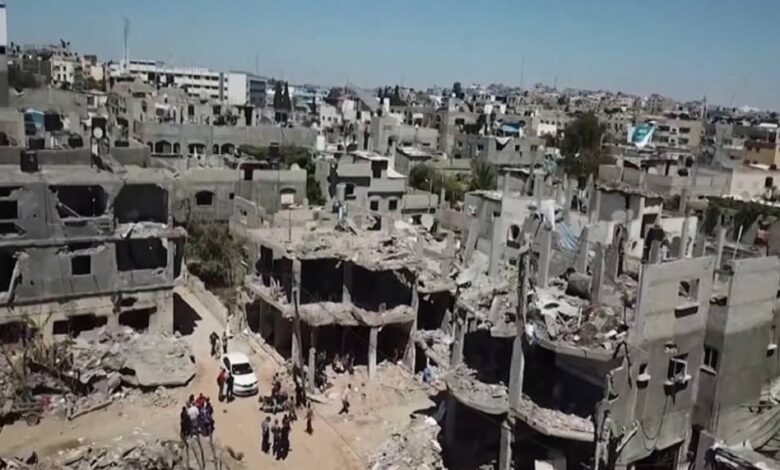Why the Regime in Iran Craves Warmongering

gaza destruction (1)
Written by
Mahmoud Hakamian
Ali Khamenei, the Supreme Leader of Iran’s regime, made a significant public statement on October 10 regarding the intensifying and deadly conflict in the Middle East. He vehemently denied any involvement of his regime, placing the blame solely on the Palestinians.
Khamenei stated, “They incorrectly attribute this move to Iran. They are mistaken. This is the work of the Palestinians themselves.”
However, to any discerning observer, it’s evident that the figure at the helm of a terrorist state in Tehran, entangled with a history of global terrorism, is deeply concerned about the possibility of scrutiny and international disdain for his regime. Especially given the ongoing sparks of uprisings inside Iran and growing international attention to the threat this regime poses to global peace and economic stability.
Many analysts describe the warmongering regime led by the Supreme Leader as an octopus, with its central command in Tehran and its influence extending like tentacles to various countries in the Middle East and even beyond.
The reality is that this inclination towards warmongering is deeply ingrained in the essence and nature of the medieval regime. This regime hijacked the Iranian people’s 1979 revolution and is fundamentally disconnected from Iran’s societal evolution and the democratic aspirations of its people.
#Media Spotlight: #Iranian Regime’s Officials Expose Their Role in Regional Crisishttps://t.co/gZ9vLLft0S
— NCRI-FAC (@iran_policy) October 11, 2023
After usurping the leadership of the anti-monarchial revolution, Khamenei’s predecessor Ruhollah Khomeini faced a potential and immensely destructive threat. He had to grapple with the vast energy and dedication of millions of young individuals set free by the 1979 revolution. This force could genuinely break the cycle of Iran’s backwardness and dependency, envisioning a new country that could spur remarkable creativity and progress in all aspects of society, from social and economic domains to arts, culture, and more. A development that would turn Iran into a beacon of freedom and democracy for the crisis-ridden region.
However, Khomeini, the monstrous figure emerging from the depths of medieval times, saw that as a threat, understanding well that in the realm of progress and aspiration for advancement, progressive forces like the People’s Mujahedin Organization (MEK/PMOI) would take the lead, leaving him and the clerical gang behind.
Hence, the only solution was to consume these vast human resources and great potential in line with realizing the dream of reviving the Islamic caliphate and expanding its hegemonic rule. With a Shiite majority among other historical and geopolitical factors, Iraq was naturally the first stop on this roadmap.
This is why Khomeini incited and set the stage for the war through his provocations. When the Iran-Iraq war began, he glorified it, referring to it as a “God-given gift” and a “divine blessing,” and when Iraqi forces left Iranian territory in 1982 and calls for peace gained volume, he claimed that “peace will bury Islam.” He clearly stated that even if it would take 20 years, the war would continue until “the last trench in Tehran remained standing or the last brick in Iran sustained.”
It’s unclear how far or for how long Khomeini would have continued this horrific war if the National Liberation Army (NLA) hadn’t shattered his war machine and hadn’t forced him to set aside his warmongering ambitions and accept a UN-brokered ceasefire, a decision he described as drinking “the chalice of poison.”
#MEK’s Impact on the Iran-Iraq Warhttps://t.co/DQC5tILQhe
— NCRI-FAC (@iran_policy) September 28, 2023
In regards to Khomeini’s embrace of the war and deliberate instigation, the statements of a regime insider named Mohammad Javad Mozaffar are enlightening. Mozaffar, who was the Public Relations director of foreign media during the Iran-Iraq war, stated in a television interview on September 29, “On April 17, 1980, suddenly the Imam announced, ‘Oh, Iraq’s tribes, rebel! Overthrow this man! Oh, Iraq’s army, come and stage a coup, overthrow this man!’ When did he do this? On April 17, 1980, five months before the war started.”
Mozaffar added, “The ruling establishment hailed the war based on a flawed analysis and they were wrong as if we were urging him [Khomeini] towards war with our slogans, provocations, and actions. Truly, the Imam and our esteemed leaders believed that if the people of Iraq willed it, they would overthrow Saddam! What kind of logic is this?”
Contrary to what this regime insider labeled as a “flawed analysis,” Khomeini’s strategy was fundamentally driven by a power-hungry, nefarious calculation, and the Iranian populace bore a heavy toll for it. The war, besides wasting the substantial energy released by the anti-monarchy revolution, guaranteed the regime’s “security” and continued existence. It served as a deceptive facade and an overwhelming shield. Khomeini was only able to subdue the revolutionary forces, with the MEK at the forefront, by harnessing the masses of war victims and the terrifying cry for “War against all infidels!”
Khomeini’s propensity for war and his ambition to expand his dominion commenced with Iraq but didn’t halt there. As subsequently affirmed by his successors, including Khamenei: “The war expanded our borders…”
One of the regime’s cronies, a cleric named Issa Tabatabai, referred to as Khamenei’s envoy in Lebanon, recently divulged in an interview with the regime’s official news agency IRNA on September 14 that Khomeini personally sanctioned the bombing of the US Marines’ barracks in Beirut in October 1983.
The belligerence and acts of terrorism persisted post-Khomeini, as acknowledged by his successors, spanning from the Khobar Towers bombing in Saudi Arabia to the AMIA bombing in Buenos Aires, and beyond.
Khamenei elaborated on this with the phrase “strategic depth,” asserting, “If we don’t engage in wars today in Iraq, Syria, and Lebanon, we must confront the enemy (indicating the uprising of the people and rebellious youth) on the streets of Iranian cities tomorrow.”

